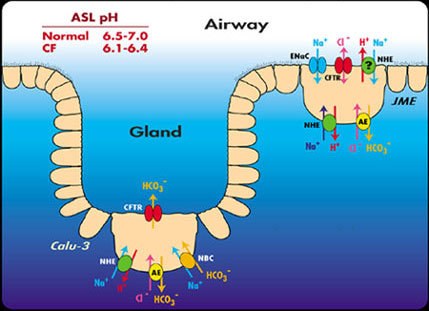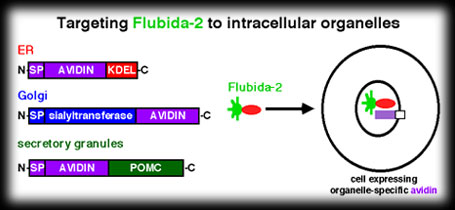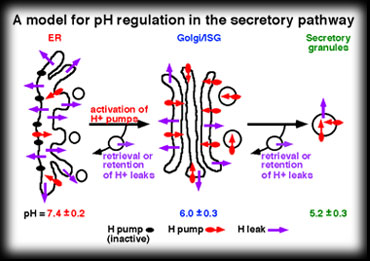

We originally showed that CFTR exhibited a significant conductance to HCO3- and could also control cell pH, and further work has strengthened the idea that the CFTR plays a key role in the ability of airway and other epithelial cells to transport HCO3- ions. These functions of CFTR may be important in the ability of the cells to regulate the pH of cytosol, surface liquid and organelles, all of which must be controlled quite precisely to assure proper cellular and tissue function. For example, airway surface liquid pH could be critical for assuring proper functioning of antibacterial factors (e.g., lysozyme, lactoferrin and defensins) and gel-sol properties of the mucus. In addition, altered organelle pH could lead to defects in production and processing of critical surface molecules (e.g., GM1) and mucus, leading to increased bacterial binding.


Hypothesis: CFTR is important for mediating HCO3- transport and also for modulating the activities of other HCO3- transporters.
We use pH-sensitive fluorescent dyes and digital imaging microscopy to study pH regulation in normal and CF airway epithelial cells. Our approach (see Sjaastad et al, 199_) allows us to recreate the physiological condition and to perfuse different solutions onto the apical and basolateral sides selectively. We are characterizing the different H+ and HCO3- transporting pathways on the apical and basolateral sides of the epithelial cells. We expect to find that the apical membranes of CF airway cells will be defective in their ability to secrete HCO3-, which would explain why airway surface liquid is more acidic in CF than in normal. We will follow up on the functional studies through the use of antibodies and PCR to identify the particular molecules involved in these transport processes.

Hypothesis: CFTR and H+ leaks play important roles in control of organelle pH, with increasing acidity being associated with lower H+ permeability and CFTR leading to alkalinzation.
Most organelles of the secretory pathway are acidic, and their specific pH's are highly regulated. In collaboration with Professor Hsiao-Ping Moore (UC-Berkeley) and Professor Roger Tsien (HHMI and UC-San Diego) we are using genetic targeting methods to determine how pH is so precisely regulated in the endoplasmic reticulum, Golgi and secretory granules, and whether there is a role for CFTR in this regulation. We generate plasmids encoding chimera proteins that can be targeted to identified organelles and then used to measure pH. For example, a GFP-sialyltransferase chimera has been used to measure pH in the Golgi of normal and CF airway epithelial cells.
 Cells are transfected with vectors containing avidin tagged to targeting sequence unique for the
organelle of interest. Membrane-permeant Flubida localizes to the expressed chimeric protein, and can be observed via fluorescence microscopy.
Cells are transfected with vectors containing avidin tagged to targeting sequence unique for the
organelle of interest. Membrane-permeant Flubida localizes to the expressed chimeric protein, and can be observed via fluorescence microscopy.
|
Contrary to some previous reports, we found that pH in Golgi of CF cells may be lower than that in normal cells, but that activation of CFTR does not seem to alter pH of this organelle. In combination with previous studies (Wu) and ongoing work, we find that acidity of the Golgi vs the ER is accomplished by activating a H+ v-ATPase and reducing H+ leak, while the acidity of secretory granules vs the Golgi is accomplished by reducing the H+ leak even further. It will be important to determine the molecular identity of the H+ leak. We hope to determine the role of H+ leaks and pumps and CFTR in regulating mucus granule pH because the sticky mucus is such a problem in CF.

Next: Effects of P. aeruginosa on airway epithelial cell function